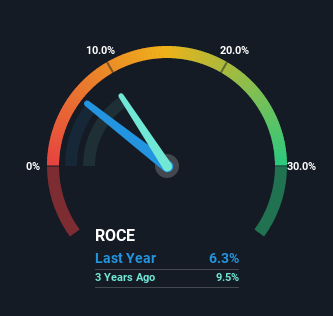- Austria
- /
- Basic Materials
- /
- WBAG:RAT
Investors Could Be Concerned With RATH's (VIE:RAT) Returns On Capital
If you're not sure where to start when looking for the next multi-bagger, there are a few key trends you should keep an eye out for. Ideally, a business will show two trends; firstly a growing return on capital employed (ROCE) and secondly, an increasing amount of capital employed. This shows us that it's a compounding machine, able to continually reinvest its earnings back into the business and generate higher returns. Although, when we looked at RATH (VIE:RAT), it didn't seem to tick all of these boxes.
Understanding Return On Capital Employed (ROCE)
Just to clarify if you're unsure, ROCE is a metric for evaluating how much pre-tax income (in percentage terms) a company earns on the capital invested in its business. Analysts use this formula to calculate it for RATH:
Return on Capital Employed = Earnings Before Interest and Tax (EBIT) ÷ (Total Assets - Current Liabilities)
0.063 = €4.9m ÷ (€114m - €36m) (Based on the trailing twelve months to December 2021).
Thus, RATH has an ROCE of 6.3%. Ultimately, that's a low return and it under-performs the Basic Materials industry average of 9.1%.
View our latest analysis for RATH

Historical performance is a great place to start when researching a stock so above you can see the gauge for RATH's ROCE against it's prior returns. If you want to delve into the historical earnings, revenue and cash flow of RATH, check out these free graphs here.
What The Trend Of ROCE Can Tell Us
On the surface, the trend of ROCE at RATH doesn't inspire confidence. To be more specific, ROCE has fallen from 9.0% over the last five years. Although, given both revenue and the amount of assets employed in the business have increased, it could suggest the company is investing in growth, and the extra capital has led to a short-term reduction in ROCE. And if the increased capital generates additional returns, the business, and thus shareholders, will benefit in the long run.
Our Take On RATH's ROCE
In summary, despite lower returns in the short term, we're encouraged to see that RATH is reinvesting for growth and has higher sales as a result. Furthermore the stock has climbed 68% over the last five years, it would appear that investors are upbeat about the future. So should these growth trends continue, we'd be optimistic on the stock going forward.
If you'd like to know more about RATH, we've spotted 3 warning signs, and 2 of them are potentially serious.
For those who like to invest in solid companies, check out this free list of companies with solid balance sheets and high returns on equity.
New: AI Stock Screener & Alerts
Our new AI Stock Screener scans the market every day to uncover opportunities.
• Dividend Powerhouses (3%+ Yield)
• Undervalued Small Caps with Insider Buying
• High growth Tech and AI Companies
Or build your own from over 50 metrics.
Have feedback on this article? Concerned about the content? Get in touch with us directly. Alternatively, email editorial-team (at) simplywallst.com.
This article by Simply Wall St is general in nature. We provide commentary based on historical data and analyst forecasts only using an unbiased methodology and our articles are not intended to be financial advice. It does not constitute a recommendation to buy or sell any stock, and does not take account of your objectives, or your financial situation. We aim to bring you long-term focused analysis driven by fundamental data. Note that our analysis may not factor in the latest price-sensitive company announcements or qualitative material. Simply Wall St has no position in any stocks mentioned.
About WBAG:RAT
RATH
Engages in the production and sale of refractory materials in Europe, Africa, the Middle East, the Americas, and the Asia Pacific.
Slight risk and slightly overvalued.
Market Insights
Community Narratives



